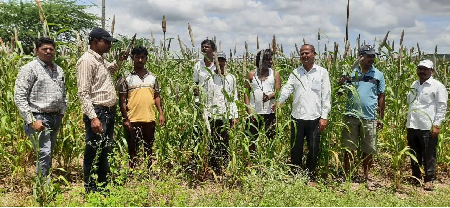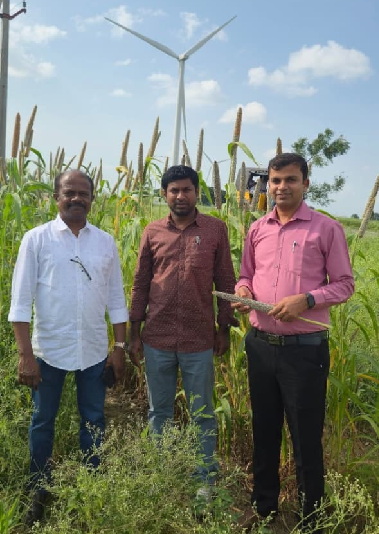Pearl millet has long been a staple in India’s semi-arid regions, valued for its resilience and rich nutritional profile. As a climate-smart crop, it provides not only energy and protein but also essential micronutrients like iron and zinc. Yet, for many smallholder farmers, its true potential remains untapped due to challenges such as low yields, limited access to improved varieties, and inadequate technical guidance. Addressing these barriers is crucial to unlock millet’s promise for both nutrition and livelihoods.
In Satara district of Maharashtra, this challenge became evident when Shri Shriram Waghde, a farmer and retired army personnel, along with his Farmer Producer Organization (FPO) members, experienced poor yields despite their commitment to chemical-free farming. Their concern was raised during the VKSA Kharif Campaign (29 May – 12 June 2025), where the issue caught the attention of experts. Recognizing its urgency, Senior Scientists of ICAR-National Institute of Abiotic Stress Management, Baramati, facilitated support from national research institutions and partner organizations.

A timely intervention came from the ICAR–Indian Institute of Millets Research, Hyderabad, under the leadership of Dr. C. Tara Satyavathi, Director, ICAR–IIMR, along with other senior scientists of (Agricultural Extension), ICAR–IIMR, in collaboration with ICAR–Agricultural Technology Application Research Institute Zone X, Hyderabad and ICAR–KVK Banavasi, Andhra Pradesh. Farmers were supplied with seeds of the biofortified pearl millet variety ABV 04, developed at ARS Anantapuram under the ICAR–AICRP on Pearl Millet, along with technical guidance for successful cultivation under chemical-free conditions.
The ABV 04 variety offered a game-changing solution. Nutritionally, it delivers 70 ppm iron and 63 ppm zinc, significantly higher than the 45–50 ppm iron and 30–35 ppm zinc found in popular varieties. Agronomically, it matures in just 86 days, yields 28.6 quintals of grain and 58 quintals of dry fodder per hectare, and adapts well to Kharif cultivation across Maharashtra, Karnataka, Andhra Pradesh, Telangana, and Tamil Nadu.
When cultivated in Satara, the variety exceeded farmers’ expectations. They reported a marked improvement in harvest compared to the previous season. The biofortified grain not only enhanced the nutritional intake of farming families but also opened new avenues for market opportunities. During a field visit, scientists and representatives from line departments witnessed the outstanding performance of ABV 04 and strongly recommended its wider adoption.

The success sparked enthusiasm among farmer groups and extension officials, who have since requested ICAR–IIMR to ensure larger seed availability and continued technical support in the coming seasons. What began as a small intervention in Satara has now become a replicable model, showcasing how science, farmer participation, and institutional collaboration can turn challenges into opportunities.
By promoting biofortified varieties like ABV 04, India can bridge yield gaps, tackle nutritional insecurity, and improve farm incomes simultaneously. The experience of Satara stands as a powerful example of how millets particularly biofortified ones can secure a healthier and more resilient future for smallholder farmers.
(Source: ICAR–Indian Institute of Millets Research, Hyderabad)








Like on Facebook
Subscribe on Youtube
Follow on X X
Like on instagram